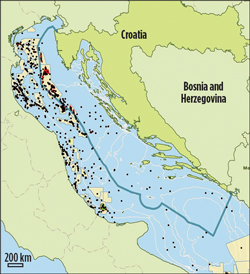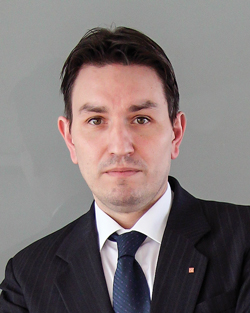Croatia opens offshore to expand resources
World Oil: What are the current oil and natural gas production rates in Croatia? Deputy Minister Alen Leveric: During 2013, we produced an average 11,000 bopd nationwide. We also produced 26,000 boed of gas, which is equivalent to about 156 MMcfd. These rates are fairly low, due to a lack of exploration. The output is coming mainly from gas fields, however, historical production was mostly oil. WO: What is the average drilling rate per year, in terms of wells and feet per well? Leveric: During 2013, there were three wells drilled onshore Croatia, and four were drilled offshore. This rate is up slightly from 2012’s level. For 2014, we expect four wells onshore and four offshore. Most of the wells are being drilled in developed concessions. The average depth of wells drilled is ranging from 1,500 m to 6,500 m, but the majority are being drilled in shallower depths. WO: In addition to the former state company, INA-Naftaplin, which additional firms are operating in Croatia? Leveric: Eni and Edison have JVs with INA in the northern portion of Croatia. I should point out that the ownership of INA has been partially privatized since 2003. The ownership is divided among the Hungarian company, MOL, which holds 49%, and the government, which retains 44%. The remaining 7% are held by small shareholders. WO: What exploration is underway to find additional oil and gas, and in what areas? Leveric: Most exploration is being conducted in the northern licensed blocks. The largest share of that activity is appraisal work. Otherwise, there is no exploration underway at the moment. INA has one jackup active in the Adriatic Sea, and one land rig is active in the Pannonian basin, in existing blocks. WO: Where do officials believe the greatest prospects exist for further discoveries? Leveric: In northern Croatia, offshore, there are producing gas fields. In central Croatia, offshore, we expect oil and gas discoveries. And in the southern offshore portions, we expect both oil and gas discoveries. Offshore, where we now have 18 production platforms, there are many analogs in Croatia to the Italian side of the Adriatic. The structures are, perhaps, larger on the southern Croatian side. We have a couple of deposits of stranded gas in the Adriatic that have not been appraised or developed, but they are close to existing infrastructure. One of the problems we have had is a lack of investment dollars available to boost exploration and development. But we hope to improve this situation with our new licensing round. WO: Indeed, your government is about to stage Croatia’s first-ever licensing round. Please give us the details. Leveric: We have great expectations for this round, which will see final block delineation made public on April 2. You have to remember that our oil and gas sector began in 1930, as part of the old Yugoslavia. Over these many years, there has been a fair amount of production. Yet, in the last few years, under Croatian rule, INA has held all the licenses. While interest was high geologically, there was no investment by other operators, as I mentioned earlier. In 2013, we passed two laws that affect hydrocarbon E&P—the Law on Mining, and the Law on Hydrocarbons. These two laws optimize management of mineral resources, increase competition in hydrocarbon exploration and production, increase the level of investment protection, and adopt international legal best practices. In addition, they prescribe the establishment of a national Croatian Hydrocarbons Agency, which has already been done. Accordingly, per this new framework, we constructed our first-ever offshore licensing round. It is composed of 29 blocks that range in size from 1,000 sq km to 1,600 sq km. Eight of these blocks are in the northern Adriatic, in shallow water, less than 100 m deep. The remaining 21 blocks are in the middle and southern Adriatic, where water depths range from 100 m to 1,200 m. Acquisition of new offshore data began last September and finished on Jan. 21, 2014. Roughly 15,000 km of new data were acquired, targeting underexplored Adriatic basins. Offshore packages were prepared from these new data. In addition, a data room (info@azu.hr) was opened on March 10, 2014, where legacy data (2D seismic and well data) have been made available to all investors. A final list of blocks was made public on March 15. We will officially open the bidding round on April 2. Although we have not yet set the closing date for the round, which should be revealed on April 2, it most likely it will be six to seven months from the opening date. WO: What are the basic financial terms? Leveric: The blocks will be awarded as production sharing contracts (PSCs). The PSCs will include signature bonuses, work commitments and prescribed state “takes” on production. The signature bonuses and work commitments will be biddable items. In fiscal benchmarking done by IHS, the state sharing on oil has been determined to be 53.5% and around 60% for gas, making Croatia very competitive with other counties in the region, the Mediterranean and globally. We engaged IHS to help us structure this first licensing round, making sure that our average, undiscounted state take is reasonable, and in line with other countries.
|
- Advancing offshore decarbonization through electrification of FPSOs (March 2024)
- What's new in production (February 2024)
- Subsea technology- Corrosion monitoring: From failure to success (February 2024)
- U.S. operators reduce activity as crude prices plunge (February 2024)
- U.S. producing gas wells increase despite low prices (February 2024)
- U.S. oil and natural gas production hits record highs (February 2024)
- Applying ultra-deep LWD resistivity technology successfully in a SAGD operation (May 2019)
- Adoption of wireless intelligent completions advances (May 2019)
- Majors double down as takeaway crunch eases (April 2019)
- What’s new in well logging and formation evaluation (April 2019)
- Qualification of a 20,000-psi subsea BOP: A collaborative approach (February 2019)
- ConocoPhillips’ Greg Leveille sees rapid trajectory of technical advancement continuing (February 2019)




